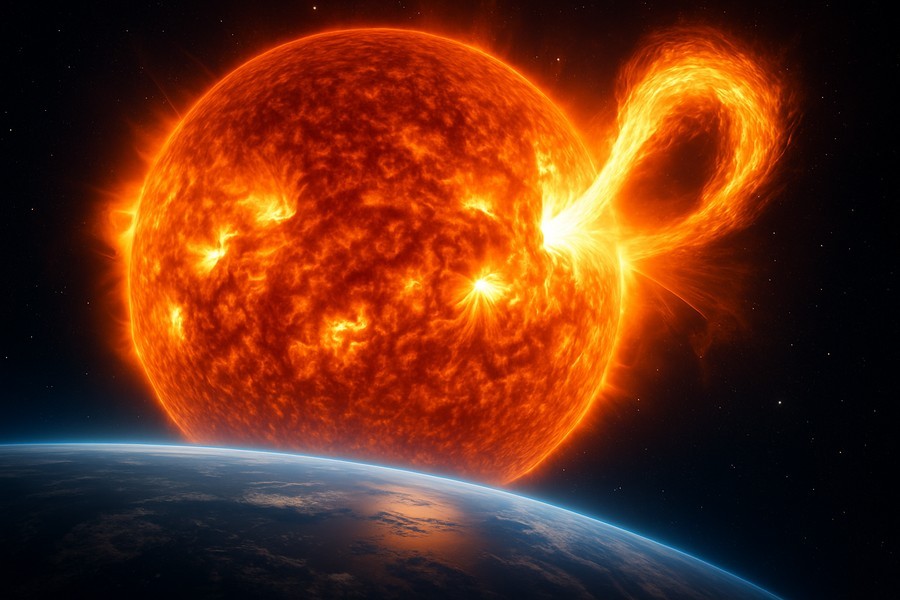
A Closer Look at the Intense Heat of Solar Flares
When it comes to solar flares - sudden bursts of magnetic energy from the Sun, they can do a lot more than just light up the sky. These powerful eruptions can spike the temperature of Earth’s upper atmosphere, interfere with radio signals, and even pose a threat to satellites and astronauts.
Scientists have known for quite some time that the plasma within these solar flares can reach scorching temperatures. However, it's been a long-standing enigma as to why certain aspects of these flares, specifically their spectral fingerprints, appear broader than they should.
Ions: The Heat Culprits in Solar Flares
A recent study has shed some light on this mystery, suggesting that during the crucial phases of a solar flare, ions (positively charged particles) reach temperatures far greater than that of electrons (negatively charged particles). In fact, ions are found to be around 6.5 times hotter, potentially reaching a staggering 60 million degrees Kelvin.
This new perspective helps to explain why the emission lines of many flares appear broader than anticipated, without the need to resort to theories of persistent turbulence.
The Importance of Hotter Ions
It's important to understand that solar plasma is a mix of charged particles - the lightweight electrons and the much heavier ions. Previous solar models often assumed that these particles would share energy quickly, leading to a common temperature. However, this new research suggests that this might not be the case during the most intense moments of a solar flare.
Hot Ions and Their Role in Solar Flares
There's a process named magnetic reconnection, where stressed magnetic field lines snap and rapidly rejoin, which is seen to heat ions far more than electrons. This process has been observed across the solar wind and near-Earth space, and it appears to follow a surprisingly consistent ratio.
Applying this rule to the Sun leads to a striking prediction: early in a flare, and high above the bright loop of hot plasma it forms, the ion temperature can skyrocket past 60 million K, remaining significantly higher than the electron temperature for tens of minutes.
The difference in temperature is crucial because it changes the way we interpret what telescopes observe. Spectral lines - bright features at specific ultraviolet and X-ray wavelengths - get broader when the particles emitting them are hotter and moving faster.
Resolving a Long-Standing Astrophysics Mystery
If ions are indeed super-hot, they vibrate more rapidly, and the light they emit spreads over a wider range of wavelengths. This broadening has been mistaken for turbulence for decades, leading to a long debate about what was causing such vigorous stirring of the flare plasma.
However, the recent study suggests that super-hot ions could be the main cause, providing a neat solution to an astrophysics mystery that has persisted for nearly half a century.
The timing of this heating process is a key factor in this explanation. In the dense loops that form after a flare brightens, ions and electrons collide frequently enough to share energy and balance temperatures relatively quickly. However, in areas where densities are lower, collisions are less frequent, allowing the temperature gap between ions and electrons to persist longer and leave a clear mark on the flare’s spectrum.
Implications for Future Observations
This new insight doesn't require a radical shift in physics. It simply applies an established heating ratio from reconnection studies in the solar wind and Earth’s magnetosphere to the points where reconnection is strongest on the Sun.
If this theory is correct, it will change how researchers interpret past observations and plan for future ones. Instruments that separate lines from different ions could directly test whether line widths correspond to the higher ion temperature rather than turbulence.
This new understanding also has implications for space weather predictions, which rely on how quickly and intensely solar flare plasmas heat up. This, in turn, determines their potential to disrupt Earth’s ionosphere and threaten spacecraft.
Ultimately, this study offers a fresh perspective on solar flares, suggesting that ions are much hotter than previously thought. This simple yet significant change in understanding may help resolve one of the most enduring mysteries in the field of heliophysics.
